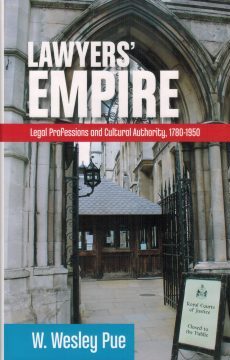In 1915 the president of the Canadian Bar Association called lawyers “children of light.” In 2015 Justice Edward Belobaba of Ontario Superior Court called lawyering “a self-regulated profession that continues to enjoy the benefits of a monopoly, including monopoly pricing.” Belobaba was angered by cost claims in a National Bank class action lawsuit in which barristers chocked up $1,000 an hour. “Access to justice for most litigants remains illusory mainly because of the high hourly rates charged by lawyers,” he wrote.
Here lies the tension in a profession deemed essential and contemptible all at the same time. If clients rarely hug their lawyers on the courthouse steps, most would agree society would be worse without them. The profession itself is capable of searing self-criticism, which brings us to Lawyers’ Empire by Professor W. Wesley Pue of the University of British Columbia’s law faculty.
Dr. Pue chronicles Swinfen v. Lord Chelmsford, a malpractice scandal from 1859. “High drama,” he calls it. “Had tickets been sold it would have been a scalper’s dream.” Patricia Swinfen, an English widow, sued her own lawyers for quietly cutting a deal in an estate settlement in breach of explicit instructions, then billing her for the privilege.
“The establishment view was that barristers’ public duties required that they enjoy authority to act without being subject to their clients’ command,” writes Pue; “The ideology of adversarial justice also held, however, that barristers were to be their clients’ champions, fiercely and without compromise advancing her position.”
Swinfen lost. The topic remains timely. Lawyers’ Empire chronicles this conflict between the ideal and practice of law.
From the 1850s English barristers were forbidden from advertising. Well into the 20th century the Canadian Bar Association frowned on purely for-profit practice. Yet when the Calgary Bar Association was founded in 1899 local barristers were preoccupied with fixing fees, regulating office hours and hounding unlicensed practitioners.
“Whereas professional rhetoric makes much of public service – sometimes elevating professional self-governance to the status of an entrenched constitutional right – the nitty-gritty of professional organization seems to have been self-interest,” writes Pue. “Their specific objectives were classic trade union stuff: money, work week and monopoly.”
This tension dates from the profession’s Victorian roots. “However lucrative successful barristers’ practices might be, the ideology of the Bar was intensely anti-commercial,” notes Lawyers’ Empire. “Founded on the notion that the best men would always come out well, it was considered ‘ungentlemanly’ to actively seek out legal work.”
Yes, but –
In 2017, Small Claims Court in Halifax cited a local barrister for charging $350 an hour in a routine traffic case. “Vulnerable clients will often sign whatever is put before them because they feel they have no choice,” wrote the Court.
In 2016 the Prince Edward Island Court of Appeal criticized a local law firm for billing $95,528 in an uncomplicated workers’ compensation lawsuit. “When a client asks his lawyer the time of day he doesn’t need to be told how to build a watch,” said Justice John Mitchell.
Note both sharp criticisms were made by fellow lawyers. It is one of the profession’s best assets. So, too is Lawyers’ Empire. Carefully researched, it treats its subject in a plain-spoken manner any client would enjoy.
By Holly Doan
Lawyers’ Empire: Legal Professions and Cultural Authority, 1780-1950, by W. Wesley Pue; University of British Columbia Press; 516 pages; ISBN 9780-7748-33097; $75






